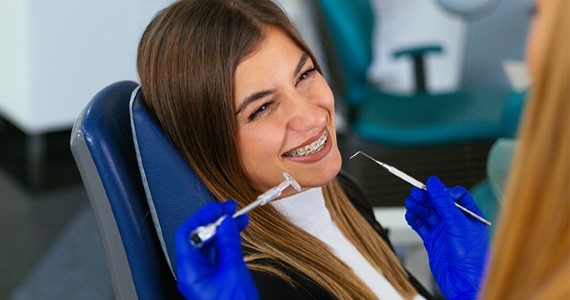Aligners vs. Braces: What's the Difference?
Explore the different ways to straighten your teeth to check which one is right for you.

Straightening your teeth can help give you a better smile with healthier teeth and gums. But what type of teeth straighteners are right for you? Let's break down the difference between traditional fixed braces and removable clear aligners. The pros and cons of each might surprise you.
The basics
When most people think of braces, they usually picture metal and wires. Traditional fixed braces involve metal brackets glued to each tooth, an archwire and elastic o-rings that connect the archwire to the brackets. An orthodontist periodically adjusts the archwire to move your teeth into the desired position.
Instead of metal and wire, dental aligners are made of clear, plastic-like material and are molded to fit your teeth. Aligners are worn for about 22 hours a day for 1 to 3 weeks at a time. Aligners are replaced every few weeks with a different set adjusted to the new alignment of your teeth. Your teeth move with each new set of aligners
Effectiveness
Fixed braces have been proven effective for decades. However, depending on how much your teeth need to be straightened, braces can take 1 to 3 years to fully realign your teeth.
A recent study has shown that aligners are effective at correcting mild to moderate conditions related to crowded teeth and misaligned bites. But aligners require careful attention and diligence. To maximize effectiveness, you must wear them for at least 22 hours a day. While some can complete treatment in 18 months, many people need to continue wearing a nightly retainer to keep their teeth in place.
Maintenance
You need to visit an orthodontist to have your braces adjusted with a new wire every 8 to 10 weeks. Some people might experience pain or discomfort after having their braces adjusted.
You also need to be very careful about what you eat. When you have braces, you should avoid hard candy, gum, popcorn, sugary drinks and starchy food. Brushing after meals is recommended to ensure no food particles get stuck between your teeth, brackets or wires.
One advantage aligners have over braces is that you can take them out of your mouth. Aligners should be removed when you're eating and while brushing and flossing your teeth. You can also brush your aligners to help keep them clean.
Be aware that you still need to avoid chewing gum and drinking sugary drinks when wearing aligners, though. And, because they are made of plastic, aligners may easily break if not properly taken care of. There's also a greater risk of losing aligners or accidentally throwing them away.
Cost
The cost of fixed braces and aligners varies greatly for each person based on their initial condition. Fixed braces from an orthodontist can cost between $5,000 to $6,000. Clear aligners can cost anywhere from $3,000 to $8,000 for treatment, with some direct-to-consumer options available for less. But you won't get the personalized care and guidance from an orthodontist.
What's best for you?
The reason to pick braces or aligners can come down to many things: your condition, maintenance, appearance or the cost. Talk to your dentist about which option might be best for you and your dental care budget. You can use our Find a Provider tool to find a dentist or orthodontist in our network.
Sources: www.webmd.com/connect-to-care/teeth-straightening/how-do-invisible-aligners-straighten-teeth www.healthline.com/health/how-do-braces-work#cleaning-teeth






